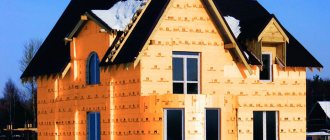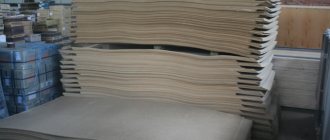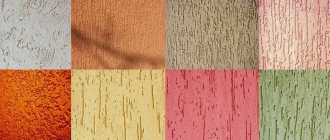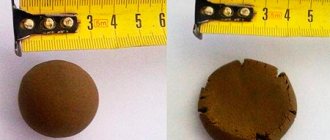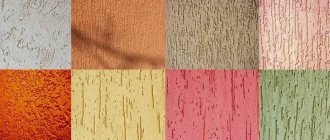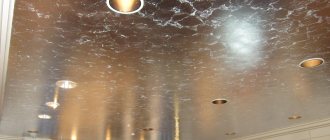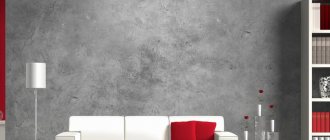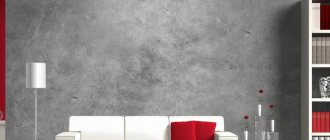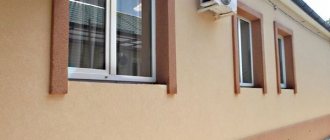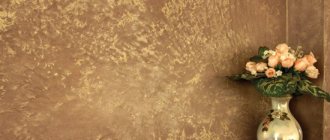The use of plaster on the walls of buildings will be a popular finishing method for many decades to come. This is due to the relatively low price of the material, its high decorative properties and simple application technique. This option for decorating walls in apartment buildings is especially relevant, in particular on balconies and loggias.
It would seem that what could be simpler than plastering a small area of the balcony walls? But even this finishing method has many nuances associated both with the specifics of a particular room and with the properties of certain brands of plaster. Let's try to understand this issue in more detail and identify the best mixture options for plastering the balcony space.
Features of decorative plasters
Plastering walls on a balcony or loggia is one of the most successful finishing options, and decorative building mixtures are ideal for this purpose. Such materials are a mass based on synthetic or mineral binders, fillers and additives, which, after drying, forms a coating with the original surface.
Interior decoration of the balcony with decorative plaster
Decorative plaster differs from ordinary plaster in composition. The final result is determined by the special components of the mixture: stone chips, dust, various fibers. The purpose of the plasters is also different. If simple building mixtures are intended for leveling, then decorative ones seal defects, decorate the surface, and serve as a finishing touch. The differences between ordinary and decorative plaster lie in the method of application, distribution, and decoration, and they largely depend on the imagination and artistic taste of the master.
The choice of decorative plasters is huge. If desired, you can turn a loggia or balcony into a beautiful, cozy room, a comfortable corner for relaxation. In addition to the appearance of the material, when choosing, you need to pay attention to the scope of its application. So, for a glazed, insulated loggia, it is quite possible to use compositions for interior work (any interior plasters). For open and uninsulated balconies, facade mixtures that are not afraid of humidity, frost and temperature changes are more suitable.
Original wall decoration on the loggia
Types of textures
It should be noted that all the plaster solutions presented above form the same textures on the facade walls of the house. Namely:
- Fur coat. This textured finish is independent of the mortar content. The method of application is important here. Therefore, to form a fur coat, they try to use plaster mixtures that contain fine fillers.
- Bark beetle This type of finishing, on the contrary, depends on the fractionation of fillers. The larger the granules present in the material, the more clearly the texture and intensity of the relief is formed.
- Lamb. This mixture also contains fillers, but not just one fraction, but several. Therefore, a lumpy surface forms on the wall, reminiscent of curls on a sheep’s wool.
- Cereal or pebble plaster. The composition includes pebbles of the same large sizes. This plaster forms a finely lumpy surface.
- Mosaic, also known as plaster with crumbs of decorative stone. Included in the group of silicone or acrylic types. For this purpose, transparent resins and stone chips are used. Essentially, a rock ripple is formed on the wall.
Varieties of textures of facade plastersSource nashaotdelka.ru
Advantages and disadvantages of decorative plaster
Finishing a loggia with plaster has many advantages. The main ones:
- possibility of use in any conditions, even in the absence of heating on the balcony;
- optimization of thermal conductivity, heat retention in the room adjacent to the balcony;
- high-quality sound insulation;
- breathable coating that does not disturb the microclimate;
- long service life in comparison with wallpaper and many other decorative materials;
- ease of care, the ability to wash with disinfectants;
- easy color change by repainting, plenty of scope for design imagination;
- the ability to combine materials, excellent compatibility with panels, wood, stone, etc.;
- large assortment and sufficient choice in price categories (from economy to premium);
- quick drying of the coating;
- resistance to mechanical damage;
- environmental friendliness, no release of harmful substances;
- non-combustibility of some types of plaster.
Finishing the loggia with mosaic plaster
Among the disadvantages of decorative plaster for a balcony, it is worth noting the difficulties with decorating walls for beginners, especially if a complex technique is chosen. In order for the coating to be truly beautiful, you will have to carefully study the issue and practice on a rough surface in advance. When mixing, the proportions of the components must be strictly observed, otherwise the composition will not obtain the proper properties.
Description of material
Using special plaster compositions, wall decoration can be made unique. Professionals use this material to create original drawings, but non-specialists, with a little practice, can learn to work with this material.
Advantages of the material
Why is it worth using decorative plaster to decorate the walls on the balcony? To answer this question, it is worth getting acquainted with the properties of this material. Its advantages:
- high rates of heat and sound insulation;
- the coating is able to “breathe”, which allows you to maintain optimal humidity levels on the glazed balcony;
- strength, coating is resistant to mechanical stress;
- The coating is easy to care for; it can be washed if necessary;
- the coating does not absorb odors, this is especially important if one of the household members smokes on the balcony.
Base material
Decorative plaster is produced on the basis of different materials, it can be:
- mineral;
- vinyl;
- silicone;
- acrylic.
All of the listed types of plaster have high performance qualities.
Advice! When choosing a plaster option, you should take into account the wall material - brick, plasterboard, chipboard, etc. It is very important to choose the right insulation. If finishing is planned using “wet” technology, then the use of mineral wool is irrational. It is better to install polystyrene foam.
Based on the size of the “grain”, there are two types of plaster:
- coarse-grained;
- fine-grained.
It is easier to work with the first version of the material, but fine-grained compositions allow you to create a variety of expressive designs.
Advice! If the finishing is done with your own hands and the master has little experience in plastering, then it is better to choose a coarse-grained composition.
Types of coating
To cover the walls on the balcony, textured plaster is most often used; with its help you can create the following types of coatings:
- oak bark;
- shagreen leather;
- mosaic, which can be single or multi-colored.
Modeled plaster allows you to create more expressive coatings, but working with this material is much more difficult. Venetian plaster looks even more elegant, but this coating option can only be recreated by professionals.
Types of decorative plaster
There are many varieties of decorative plaster, and all of them are well suited for balconies and loggias. Mixtures differ in the size of the filler particles, the type of base and the texture created.
To size
Depending on the type and fraction of added particles, all plasters can be divided into large-relief and small-relief.
Large-relief
They are applied to the surface quite easily, they immediately seal up any defects remaining after leveling, and are ideal for beginners. A noticeable relief in such plasters is created by small pebbles, crystals, and fibers. The mass can be applied in an uneven layer using available tools. After drying, large-relief plasters resemble untreated stone.
Large-relief coating hides minor defects on the wall surface
Shallow-relief
It is worth working with such mixtures if you have some experience, because on the finished fine-textured coating you will be able to examine every detail. Such plasters are applied only to a carefully leveled base. After drying, the layer is sanded, or various techniques are used on the uncured mixture to create a relief. Fine-grained plasters are ideal for the manufacture of complex decorative elements.
Fine grain Venetian plaster
By composition
All plasters on the construction market differ in the type of main components included in the composition, which determines their properties and application features.
Mineral
This is the most common type of decorative plasters. Mineral compositions are used much longer than others. They are the most affordable, market-rich, 100% environmentally friendly, durable and beautiful. Decorative plaster based on mineral components has excellent performance characteristics and is non-flammable. The downside of most of these materials is their intolerance to low temperatures, since they begin to crack due to changes.
This group includes the following types of plasters:
- Plaster. They are used as leveling mixtures or applied to impart decorative properties. Environmentally friendly, plastic, breathable, easy to form and distribute, help create complex reliefs. They quickly gain strength and have high adhesion to most building materials. The disadvantage is the ability to absorb moisture and rapid loss of strength due to poor moisture resistance. To improve the properties, hydrophobic additives are introduced into the composition of gypsum plasters, and the finish is covered with moisture-proof paint.
- Calcareous. Such products also require the introduction of hydrophobic modifiers, although they are more moisture resistant than gypsum. They are considered vapor-permeable, environmentally friendly, plastic, have a bactericidal effect and prevent the growth of mold, mildew, and rot. The strength of lime plasters is not too high. They should only be used on glazed loggias.
- Cement-sand. The most wear-resistant of mineral compositions, they are not afraid of dampness, and after the introduction of special modifiers they can withstand repeated freezing and thawing. They serve for many years and can be used for leveling and as a decorative finish. For finishing work, white cement-based products are usually produced.
Gypsum mineral mixture Brozex for walls and ceilings
Also on sale are combined decorative plasters: cement-lime, gypsum-lime, cement with the addition of polymers. The latter are recommended for use if the house is prone to shrinkage or is located in a seismically active zone. The introduction of polymers into the composition makes conventional cement plaster more elastic, resistant to vibration and shear. Coloring substances can be added to any mineral mixture at the mixing stage, although after drying the mass will turn very pale. Therefore, a more popular option is to paint the already dried layer in the chosen color.
Acrylic
These plasters are based on acrylic resins, which impart powerful moisture-repellent properties. After curing, the water-dispersion mass will have high strength, frost resistance, and no reaction to fluctuations in temperature and humidity.
Acrylic plasters are not afraid of ultraviolet radiation, do not fade, are impact resistant and have the ability to repel dust, so they can be used even on unglazed balconies. The surface is easy to clean with water; it will not be damaged by SMS and other cleaning compounds.
Decorative acrylic plaster “Fur Fur” De Luxe
Decorative acrylic plaster is characterized by high elasticity. It is easily applied to any surface (wood, brick, foam plastic, gas block, foam block, mineral wool, OSB), and does not crack from vibration. Acrylic-based material is more expensive than mineral material, but as it dries it turns into a beautiful, original facing coating. The only disadvantage of acrylic plaster is reduced vapor permeability, so the walls should be additionally treated against fungus and mold.
Silicone
The composition of such plasters includes siloxane - rubber with low molecular weight, or classic silicone (organo-silicon polymer). These substances have the highest elasticity, which is why decorative plasters based on them are often called elastomeric. Any relief can be formed on an uncured plastered surface.
Silicone plasters are very durable, serving for decades without loss of aesthetic and strength properties. The mixtures adhere to any type of substrate, are easy to apply, resistant to all adverse factors, and repel water. Despite their moisture resistance, they are considered vapor permeable and do not disturb the indoor microclimate.
Silicone decorative plaster
Silicone plasters are suitable even for open balconies and external elements of buildings. Their only disadvantage is their high cost, so to reduce the cost of the composition, some silicone resins are often replaced with acrylic ones. Also on sale are combined decorative plasters based on silicone and silicate additives (for example, liquid potassium glass), which increase the strength indicator.
By invoice
Designers prefer to work with modeled (structural) plasters, which allow them to create the most unusual decorative effects on the wall. For example, mixtures for antique finishing with a craquelure effect are popular. The compositions of such plasters include special components that, when dry, cause the top layer to crack, forming a “network of wrinkles.” If you paint the cracks with a contrasting color, the result will be amazing.
No less often, plaster with a fabric-reaper effect is used with the addition of mineral pigments that refract in the rays of light. They make the coating look like silk. “Soft gold”, which appears due to the presence of special granules in the plaster, also looks interesting. Below are described other options for decorative mixtures that are suitable for finishing balconies and loggias.
Smooth decorative covering on the balcony
Kameshkovaya
This material contains small pebbles of strictly calibrated size, and the appearance of the finish will depend on their specific size. Acrylic or silicone is usually used as a binder. Since the mass is applied in a thin layer, the use of cement is impractical: it provides sufficient strength only at a certain thickness of the material. Externally, after applying pebble plaster, the balcony will look like it is sprinkled with pebbles or sand, and the colored options will not require further processing.
Mineral decorative stone mixture Ceresite
Marble
The filler in this material is marble in the form of chips with a fraction of 0.5–5 mm. To enhance the decorative effect, plaster contains various dyes and additives to increase strength and elasticity: resins, plasticizers, lime. After drying, the marble plaster is varnished, otherwise it will not be possible to wash it, and dust will accumulate on the surface.
Balcony finishing with marble plaster
Bark beetle
Externally, this plaster looks like a wood surface eaten away by bugs. The grooves can be shallow or deep, frequent or rare, and the specific effect depends on the additional components in the composition and on the skill of the finisher. Bark beetle type plaster goes well with any interior; it can be tinted before application or painted after drying.
Balcony decoration with bark beetle
Venetian
Decorative plaster “Venetian” is considered the most expensive and noble. It is applied in several layers, using a rather complex technique, and after drying it imitates the surface of natural stone: marble, granite, onyx, malachite. This effect is achieved by introducing stone flour into the composition, which provides highly artistic properties. Venetian plaster can only be used on closed balconies and loggias.
Venetian plaster coating
Textured plaster
This material is used to create various relief shapes. It contains gypsum, as well as sand, pebbles, fibers, mica, and threads. Plaster is applied manually, with rags, sponges, textured rollers, and the application technique is complex and requires experience. Since the plaster contains gypsum, it can only be used on insulated, dry balconies and loggias.
Applying a textured gypsum coating
Options for finishing a balcony with your own hands - how to plaster
Decorative plaster can be coarse-grained or fine-grained. Its relief is determined by the composition and size of the additives. Large-relief mixtures must be applied with a special tool in a not too even layer. If a loggia is being processed, the decorative plaster should have an additional texture. After it dries, the surface will resemble untreated stone in appearance.
Fine-grained compounds are applied to pre-leveled walls. Therefore, it is better to use them if you have extensive experience in finishing work.
The walls must first be thoroughly puttied. After they dry, they should be sanded. If desired, methods for creating small decorative details and various reliefs are used. After the material dries, even the slightest defect will be visible on it.
The surfaces will become smooth and then you can give them the required texture. The final coating is recommended to be painted or tinted. The use of rollers or brushes will make it more aesthetically pleasing.
If you use plaster on balcony walls with imitations, then it is better to choose wood, artificial stone on the floor or walls, or tiles.
Features of plaster for cold glazing
When finishing a cold balcony, special care is required. It is due to the fact that every time the door to the room is opened, a warm stream of air condenses on the surface. Therefore, it is better to first coat the walls and ceiling with a moisture-resistant compound or water-repellent primer.
You cannot leave the door to the room open with the windows closed unless the coating is protected with waterproofing plaster.
Leveling plaster for walls
Leveling compounds are used to make walls smooth, correct small and large defects, and smooth out curvature. They improve the performance characteristics of walls and, unlike gypsum plasterboard or OSB sheets, occupy a minimum of free space.
You can apply a decorative layer on top of the leveling plaster or stick panels, tiles, or wallpaper. When choosing a material for a balcony, you should pay attention to its frost resistance, ability to withstand temperature changes and high humidity. Typically, cement-sand mortars with the addition of polymers are used as leveling solutions. If you have to apply too thick a layer of plaster, additionally use reinforcing mesh or even metal profiles.
Extruding façade mixture
Specifics of working with the material
Work with leveling plaster is carried out in three stages:
- wall preparation;
- mixing the solution;
- applying the solution.
When preparing the base, you need to remove the old coating. If installation of thermal insulation is planned, it is also carried out at this stage. Smooth concrete walls are covered with nicks and small chips to make them rough, otherwise the plaster will not adhere well. For this purpose, use a metal brush or chisel. Afterwards, the wall is dusted off and treated with deep penetration soil, allowing it to dry thoroughly.
The plaster solution is mixed according to the instructions on the package, accurately measuring all components. Immediately mix a small portion of the plaster so that you have time to apply it before it hardens. The composition is thoroughly mixed, otherwise lumps may remain in it. Add the dry composition to the water, and not vice versa. Otherwise, even using a construction mixer will not prevent the mass from clumping.
For perfectly even application of plaster, guide strips (beacons) are used, which will set the desired plane. They are placed every 50 cm, then hidden under a layer of plaster. After the first layer has dried, it is rubbed with sandpaper or a grater. If necessary, apply another layer. It is advisable that the total thickness of the plaster does not exceed 2–3 cm, which is quite enough to level the walls on the balcony.
Working with brick walls
Often the walls on balconies and loggias are brick. In this case, working with leveling plaster will have some peculiarities. To ensure that the solution is firmly held on the surface, all seams are cleaned to a depth of 8–10 mm. To prevent porous bricks from becoming saturated with moisture and to prevent swelling of the plaster, the wall is coated with a deeply penetrating primer 2-3 times.
After the soil has dried, apply the plaster in a thin layer (less than 1 cm), using a spatula, embed the reinforcing mesh in it, the edges of which are laid with an overlap of 15 cm. Then, as the solution dries, they place beacons and make a full leveling of the wall, let it dry and rubbed out.
Preparing a brick wall
Fake diamond
Imitation of rough stone
It is irrational to use natural stone as finishing, as it is too heavy. A good alternative would be an artificial one, which looks no less elegant. It helps to create an amazing look for a room decorated in any style, from classic to country, techno or modern.
Imitation of brickwork is especially popular in the interior decoration of balconies. It looks elegant on the external wall of both the facade and the partition. Creates a cozy and peaceful atmosphere.
False fireplace
Choose a building material that suits your interior and climate. Weigh the disadvantages and advantages of each type of raw material. Be interested in its properties and qualities in different environmental conditions.
It’s not enough just to choose a material. They need to properly and aesthetically tile the room. Before starting work, we recommend that you carefully study the technology of masonry and cladding, or hire a specialist.
This way your balcony will become a comfortable room where you can relax with a book and a cup of aromatic tea. To make the space seem larger, use special techniques to visually increase the space when creating the interior. Remember, the size of the loggia does not matter - any area can be turned into a cozy corner for work or relaxation.
Watch this useful video to help you choose the right building material for your apartment:
Decorative plaster finishing technology
In fact, working with decorative plaster is not difficult. If you carefully read the recommendations of the experts and prepare the solution correctly, then even a beginner can cope with its application.
Plastering tools
A very necessary device for applying and leveling plaster is a trowel. It is worth choosing a good quality tool that is convenient and effective to work with. The following tools may also be required:
- construction falcon - a “shield” made of light metal 40 x 40 cm with a handle in the middle, used for supporting and smoothing plaster;
- spatulas of different sizes made of rectangular or trapezoidal stainless steel - used for applying and smoothing the solution;
- the rule is 2–3 meters long - helps to correct the applied layer of plaster and tighten it;
- polyurethane grater - depending on the effect, smoothes or decorates the surface;
- rubber roller with a pattern or plastic stencils - used for applying patterns to a layer of plaster;
- construction buckets or guns - needed for faster application of the solution if the surface area is large.
Tools for working with decorative plaster
Also for plastering you may need a plumb line, a level, a mixer or drill with an appropriate attachment, sponges, brushes, containers for the mixture, and mittens for finishing grouting.
Surface preparation
The walls are cleaned of dust, dirt, and old finishes. The cracks are widened, filled with cement or gypsum plaster, and the same is done with holes and chips. Protruding tubercles are sanded off with sandpaper or a grinding machine. A primer with moisture-repellent properties is applied to the entire surface. Plastering work begins only after the soil has completely dried.
Preparing walls for applying decorative coating
Application of the composition
First, mix the decorative plaster with water in the required proportion until a homogeneous mass is obtained using a construction mixer. Afterwards, take the solution onto a trowel and apply it to a small section of the wall. Level the mixture so that the layer does not exceed 2-3 cm, and for some compositions - 1-1.5 cm (the maximum layer thickness is always indicated in the instructions). Leveling is convenient to do with a grater, a wide spatula or a rule.
A popular method of applying decorative mixtures is stretching. It is carried out with a trowel, which is held at an angle of 60 degrees. After drying for some time, the solution is rubbed with a metal float, preparing for application of the finishing (front) layer. Usually its thickness does not exceed 2 mm, although the exact parameters always depend on the specific type of plaster.
Immediately after completing the front layer, they begin to form the relief. For example, an imitation of small pebbles is created using circular movements in one direction. To obtain the structure, the “bark beetles” make movements of different directions and amplitudes, after which characteristic grooves remain. Waves are obtained after applying the mass in layers of equal width and rubbing them with zigzag strokes. It is enough to rub the stone plaster smoothly, and the filler itself will form the desired texture.
Final stage
After the walls have dried, you can begin their final decoration. If the composition already contains pigments, you can simply coat it with varnish to give a beautiful shine. Unpainted solution should be treated with suitable paint using a sprayer, brush, or roller. The paint should get into all the recesses, but it is not recommended to apply it too thickly.
To give an original effect, you can first paint the walls with a fairly dark or rich composition, and then glaze with translucent light paint. Glazing with pearlescent composition or paint with a metallic effect looks great. After drying, the walls are covered with varnish or wax, which is carefully rubbed into the surface.
Applying wax to decorative coatings
Tools
The craft of plaster has developed over the centuries. During this time, masons and plasterers developed the most convenient form of tools for applying and processing mortar. So you will need the usual tools and equipment for plastering. First of all - a trowel. It is convenient to apply and smear the solution, as well as form a pattern.
In addition to this you will need:
- spatulas;
- roller;
- brushes;
- grater;
- sponge;
- rule;
- plumb line or level;
- container for plaster mortar;
- mixer;
- masking tape;
- stamps or other improvised means for applying a pattern;
- cutter (for cutting sheet insulation);
- rags.
Very useful video, information on the tool is towards the end of the video.
Features of plaster for cold glazing
Cold glazing refers to covering balcony windows with single glass to protect against wind and precipitation. The room will only become slightly warmer from such glazing (no more than +5 degrees compared to the street). When you open the door from the apartment, moisture from the warm air will condense on the walls. This necessitates their treatment with a water-repellent primer before plastering.
You can also use waterproofing plaster mixtures, for example, silicone-based. It is important to carry out all work on applying solutions to walls at a temperature not lower than +8 degrees. The temperature must remain positive until the composition reaches full strength, otherwise the durability of the finish will decrease.
Waterproofing plaster mixture
Ceramic tile
In terms of practicality and durability, the ideal material for decorating a loggia or balcony is ceramic tiles. If installed correctly, the service life of this “cladding” will be a long period of time. The material does not absorb moisture, does not fade, and is easy to wash.
Ceramic casting, thanks to a wide selection of shapes, colors and textures, will allow you to bring any design idea to life.
Warm plastering of the loggia
Often, owners decide to create an additional room on the loggia, so they install insulation on the walls. They start with choosing quality material. Expanded polystyrene, which is moisture-resistant, rigid, and durable, is best suited for plastering. You should not buy mineral wool, otherwise mold will settle on the walls.
Before attaching the insulation, the walls must be prepared - they are cleaned of dust, dirt, and impregnated with water-repellent compounds. The cracks and joints are treated with waterproofing, for example, a mixture of cement and PVA, and glued with a special tape.
The cracks under the window sill and in the places where the frame adjoins the side walls are especially carefully sealed. The protruding parts of the foam from the windows are cut off with a utility knife, covered with a water-repellent agent, and also taped.
Warm floor on the loggia
Installation of insulation under plaster
To attach the insulation, use a cement mixture, ready-made mastic or foamed polyurethane glue. Additional fasteners are special dowels for foam plastic (5–6 pieces per square meter). It’s good if the insulation sheets have tongue-and-groove joints - they fit together without a gap.
First, the ceiling is finished with slabs, then the cold wall under the window, then the side partitions. The wall that is common to the balcony and the apartment does not need to be insulated at all. Periodically check the evenness of the plane with a level, especially in corners and slopes. If necessary, compensating pads are made from the same insulation, which are glued to the back side with polyurethane glue. Coincidence of vertical seams between the plates is not allowed; they are mounted only with an offset.
Balcony insulation with penoplex
Base reinforcement
After completing the installation of the insulation, use a float to eliminate small differences between the surfaces of adjacent slabs. If necessary, install additional dowels. The seams are foamed, a self-adhesive window profile with a plastic mesh is installed. This must be done carefully, because it is almost impossible to tear off and re-glue the profile.
A layer of reinforcing putty is applied to the mesh. To protect the outer corners from damage, perforated corners with a mesh are attached, recessed into the solution. Afterwards, the insulation is reinforced with fiberglass mesh over the entire surface of the walls. At the first stage, the corners of door and window openings are reinforced with “kerchiefs” made of mesh, gluing them diagonally at an angle of 45 degrees. Then the rest of the walls are reinforced by gluing fiberglass directly onto the plaster layer. As the mesh is sunk, another thin layer of plaster is applied and allowed to harden for a day. Check the finished surface with a level and, if necessary, carry out additional local plastering.
Reinforcement of insulation before plastering
Proper care of the walls on the balcony
The decorative coating does not require special care. Almost all plasters repel water, so surfaces can be wiped with wet rags or damp wipes. Do not wash plaster with abrasive agents, which will damage the paintwork and scratch it. If dust settles on the walls, treatment with antistatic agents will allow them to always remain clean. In general, covering a balcony with decorative plasters is a very good solution, since it will not cause unnecessary hassle, and the finished coating will look stylish and attractive.
Decoration options
Due to its composition, decorative plaster for balconies and loggias can be finely or coarsely textured. While the solution is being prepared, it can be changed to any desired color if desired.
Once the finishing is complete (when the plaster is dry), you can cover it with a protective agent, such as: transparent varnish, colored paint.
Coarse-grained paint is easier to use, it’s easy to apply yourself, and you don’t need to perfectly level the walls. Can be applied to brick or concrete, after drying it will look like natural stones.
Using different application methods, you can get interesting solutions:
- antique plaster;
- textured coatings (in this form, various tools are used, such as a sponge, paper, or you can create a pattern with your own hands).
To decorate balconies with decorative plaster with fine-grained filler, you need to perfectly level the walls, then the layers will be smooth.
Special devices will help for this: brush, trowel, roller, stamps. With their help, good artistic effects are obtained.
